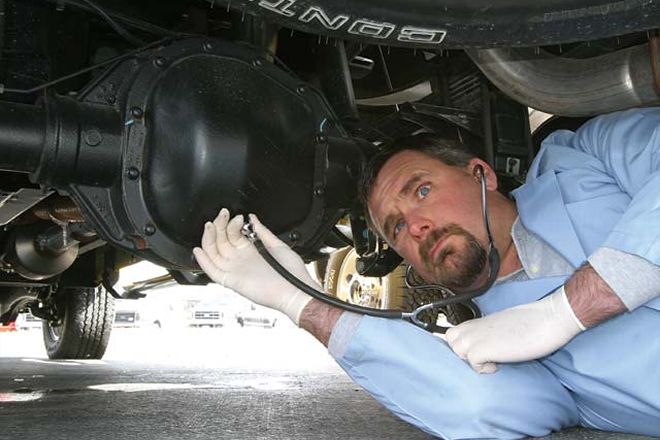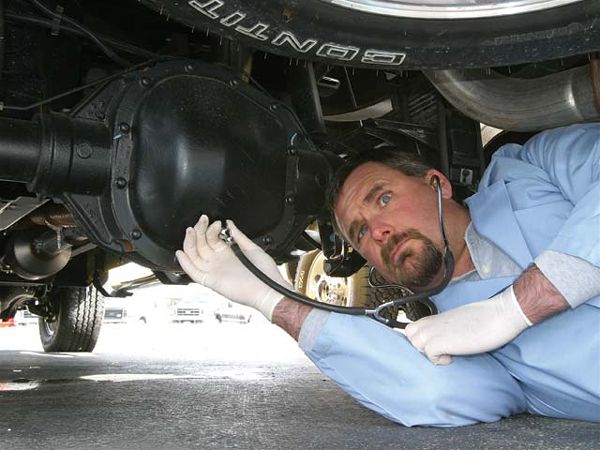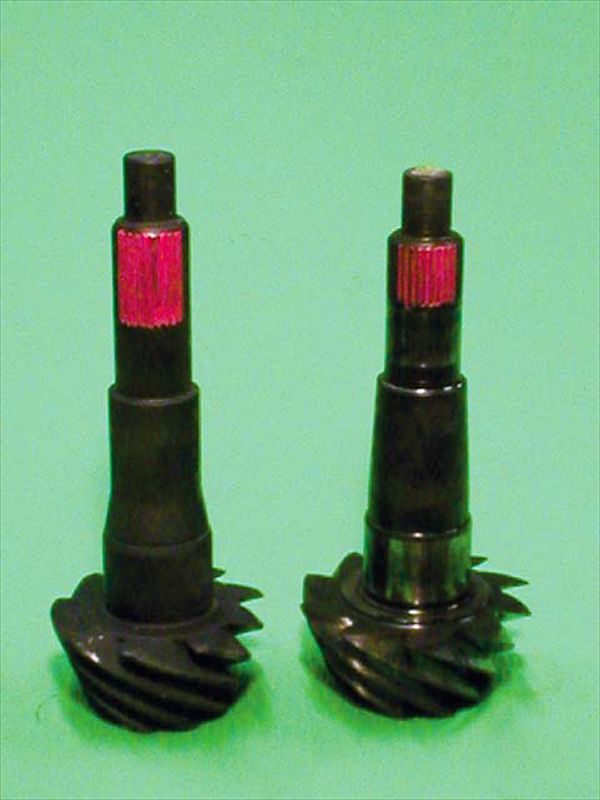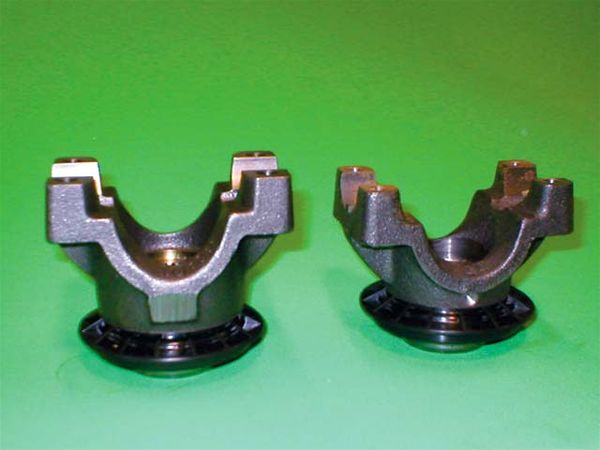
 Ken Brubaker
Senior Editor, Four Wheeler
Photographers:
Sam Africano
Ken Brubaker
Senior Editor, Four Wheeler
Photographers:
Sam Africano
Strapped under many 3/4- and 1-ton Ford pickups are rear axles that are somewhat mysterious. Often referred to as the Sterling 10.25- or 10.50-inch axles, they've been used in the vast majority of aforementioned trucks since the mid-'80s, yet most folks don't know much about them.
Ford Motor Company probably prefers that these axles be referred to as the Ford 10.25- or 10.50-inch, but they've picked up the nickname Sterling because they're manufactured in Sterling, Michigan, by Visteon, a Ford supplier. We're going to jump on the bandwagon and call them Sterling axles because that's what most people call 'em.
Over the past 20 years there have been three variations of Sterling axles used under the 3/4- and 1-ton Ford pickup trucks. They're all very similar, and visually the difference between the three generations is negligible. All three use the same diff gear cover, and all three use a unique O-ring design on the axleshafts, which are less likely to leak when compared to standard gaskets. Speaking of the axleshafts, the ones found in the Sterling axles seem to be above average when it comes to reliability.

One of the ways this is illustrated is by the fact that there are no mass-produced aftermarket axleshafts available for the Sterling axles at the time of this writing. The first- and second-generation 10.25-inch axles differ in pinion shaft length. The second generation is more desirable because it has longer splines on the pinion shaft, and a bigger yoke. If you're not sure which one you have, remove the yoke and measure it. A long yoke has an overall height of approximately 3.5 inches, and a spline length of approximately 1.75 inches. A short yoke measures approximately 3.25 inches in height, and has a spline length of approximately 1.25 inches.
Following are some specs for each of the three Sterling axles, as well as some weak points, fixes, and aftermarket upgrades for each. Clearly, we couldn't address every single spec or weak point, and your experience may vary, depending on how you use your rig and how it's modified.
The information contained is accurate to the best of our knowledge and is the result of our research, manufacturer information, and from tapping the wealth of knowledge from axle specialists like Custom Differentials in Bloomsdale, Missouri. The technicians at this shop south of St. Louis know axles inside and out, and they take a proactive approach to attacking potential problem areas before breakage occurs. When breakage does occur, these guys are the masters of the torque wrench and can either fix the problem for you or sell you the parts you need through their new parts division.
 Here you can clearly see the difference in spline length between the long-pinion 2nd generation 10.25-inch Sterling (left) and the short-pinion 1st generation 10.25-inch Sterling. The splines differ by about 1/2 inch, and the shorter pinion was known to wobble and cause failure of the ring-and-pinion.
Here you can clearly see the difference in spline length between the long-pinion 2nd generation 10.25-inch Sterling (left) and the short-pinion 1st generation 10.25-inch Sterling. The splines differ by about 1/2 inch, and the shorter pinion was known to wobble and cause failure of the ring-and-pinion.
Fact: This was the first Sterling axle used under a Ford 3/4- or 1-ton pickup
Found under: '85-'92 F-250 and F-350
Type: Full-float, semi-float (depending on gross vehicle weight)
Weight (lb., approx.): 310 (single wheel), 330 (dual wheel), 258 (semi-float)
Ring gear diameter (in.): 10.38
Pinion shaft length (in.): 10 1/8
Pinion shaft spline count: 31
Axleshaft spline count: 35
Axleshaft diameter (in.): 1.5 (at the splines)
Hypoid offset (in.): 1.50
Gear ratio range: 3.08-7.17
Brakes: Drum
Normal GAW range (lb.): 6,250 (single wheel full-float), 8,250 (dual wheel full-float), 5,300 (semi-float)
Nominal GCW rating (lb.): 18,500 (single/dual wheel full-float), 17,000 (full-float)
Output torque maximum (lb-ft): 8,300 (single/dual wheel)
Output torque continuous (lb-ft): 2,000
Weak points: The guys at Custom Differential note that the spline length on the yoke and pinion is insufficient. This can cause the yoke to wobble and move, causing wear on the pinion bearings, thus affecting preload. This leads to leakage through the splines and pinion seal. Ultimately, pinion bearing and ring-and-pinion failure loom. Towing or running 38-inch-diameter or larger tires with 4.10:1 or numerically higher ratios has also shown to contribute to failure. This is the result of the decreased pinion size of the higher ratios and the tendency of the pinion nut to loosen, causing the pinion teeth to break. Finally, running 38-inch-or-larger tires commonly causes excess spider-gear wear and failure, along with case failure. Custom Differentials has actually seen the case split in half when this occurs.
Fixes: You'll get longer splines by upgrading to the 2nd generation 10.25-inch ring-and-pinion. Switching to a three-spider gear setup will go a long way to address the other issues (see the information on the three-spider gear upgrade under the 10.50-inch "Hot Tips" section).
Hot tips: Apply silicone to the splines of the yoke before assembly to seal the yoke to the pinion shaft and stop lube leakage. Custom Differentials also notes that every time they rebuild a 1st-generation 10.25-inch axle using aftermarket parts, it automatically includes an upgrade to the 2nd-generation long pinion setup.
Fact: This axle is almost an exact copy of the 1st-generation 10.25-inch, but it did receive a larger yoke and pinion with increased spline contact area in an effort to solve problems caused by the smaller yoke/spline of the 1st generation.
Found under: '93-'98 F-250 and F-350
Type: Full-float, semi-float (depending on gross vehicle weight)
Weight (lb., approx): 310 (single wheel full-float), 330 (dual wheel full-float), 258 (semi-float)
Ring gear diameter (in.): 10.38
Pinion shaft length (in.): 10.50
Pinion shaft spline count: 31
Axleshaft spline count: 35
Axleshaft diameter (in.): 1.5 (at the splines)
Hypoid offset (in.): 1.50
Gear ratio range: 3.08-7.17
Brakes: Drum
Normal GAW range (lb.): 6,250 (single wheel full-float), 8,250 (dual wheel full-float), 5,300 (semi-float)
Nominal GCW rating (lb.): 18,500 (single/dual wheel full-float), 17,000 (semi-float)
Output torque maximum (lb-ft): 8,300 (single/dual wheel)
Output torque continuous (lb-ft): 2,000
Weak points: Like the 1st-generation 10.25-inch Sterling, tires 38 inches or taller used in conjunction with 4.10:1 or numerically higher gearing tends to bring on pinion tooth failure due to the decreased pinion size of the higher ratio pinion teeth. This combination also contributes to excess spider-gear wear and failure along with case failure. Like the 1st generation, it is not uncommon to see a case split in half.
Fixes: Switching to a three-spider gear setup will go a long way to address these issues (see the information on the three-spider gear upgrade in the 10.50-inch "Hot Tips").
Hot tip: If you do a lot of towing, use a larger-capacity cover to keep the axle cool. Custom Differentials recommends and sells a finned aluminum unit for this purpose.
 On the left, you can clearly see how much larger the 10.25-inch Sterling long-pinion yoke is compared to the smaller Sterling 10.25-inch short-pinion yoke.
On the left, you can clearly see how much larger the 10.25-inch Sterling long-pinion yoke is compared to the smaller Sterling 10.25-inch short-pinion yoke.
Since we 'wheelers can't seem to leave anything stock for long, the aftermarket has responded with a variety of upgrades to make our rigs better. Following are but a sampling of the products available from Custom Differentials for the Sterling 10.25- and 10.50-inch axles.
Aftermarket gears: Yukon Gear, U.S. Gear, Richmond Gear
Limited-slip differentials: Eaton, Ford Traction-Lok (two- and three-spider), Auburn
Locking differentials: Detroit, ARB, Lock-Right
Fact: This axle received a larger ring gear, which improved its overall strength and addressed the premature failure issues of the 10.25-inch axles when used with 4.10:1 or numerically higher gear ratios. Unfortunately, it was designed with a smaller pinion bearing than its predecessor.
Found under: '99-'05 F-250 and F-350
Type: Full-float
Weight (lb., approx): 333 (single wheel), 348 (dual wheel)
Ring gear diameter (in.): 10.50
Pinion shaft length (in.): 10.50
Pinion shaft spline count: 31
Axleshaft spline count: 35
Axleshaft diameter (in.): 1.5 (at the splines)
Hypoid offset (in.): 1.50
Gear ratio range: 3.08-7.17
Brakes: Disc
Normal GAW range (lb.): 9,750 (single/dual wheel)
Nominal GCW rating (lb.): 26,000 (single/dual wheel)
Output torque maximum (lb-ft): 10,660 (single/dual wheel)
Output torque continuous (lb-ft): 2,900
Weak points: This axle uses an inner bearing and race that is not as large and strong as the bearing and race used in the 10.25-inch axle. Also, the ring gear is mounted to the carrier using bolts that are non-shouldered and tend to loosen, resulting in the possibility of catastrophic damage to the differential. This is actually a problem that affects both the 10.25- and 10.50-inch Sterling axles.
Fixes: To address the bearing and race issue, you can use the ring-and-pinion from the 2nd-generation 10.25-inch. The trade-off is that you'll get a slightly weaker ring-and-pinion, but you'll get a larger inner bearing and race. To solve the ring-gear bolt problem, replace all of the bolts with shouldered bolts. The technicians at Custom Differentials can set you up with shouldered Dana 70 ring-gear bolts.
Hot tips: If you're short on cash during a rebuild (depending on the ratio you want to use, factory parts for the 10.50-inch Sterling can be almost double the cost of 10.25-inch aftermarket parts), you can use the 2nd-generation 10.25-inch case/carrier and gearset in the 10.50-inch housing (as mentioned above). This can significantly lower your parts bill. Also, a three-spider case/carrier is available instead of a normal two-spider gear case/carrier. This update increases the strength and longevity of the differential because the third-spider gear helps share the load when delivering power to the tires and helps reduce spider-gear wear and failure.


